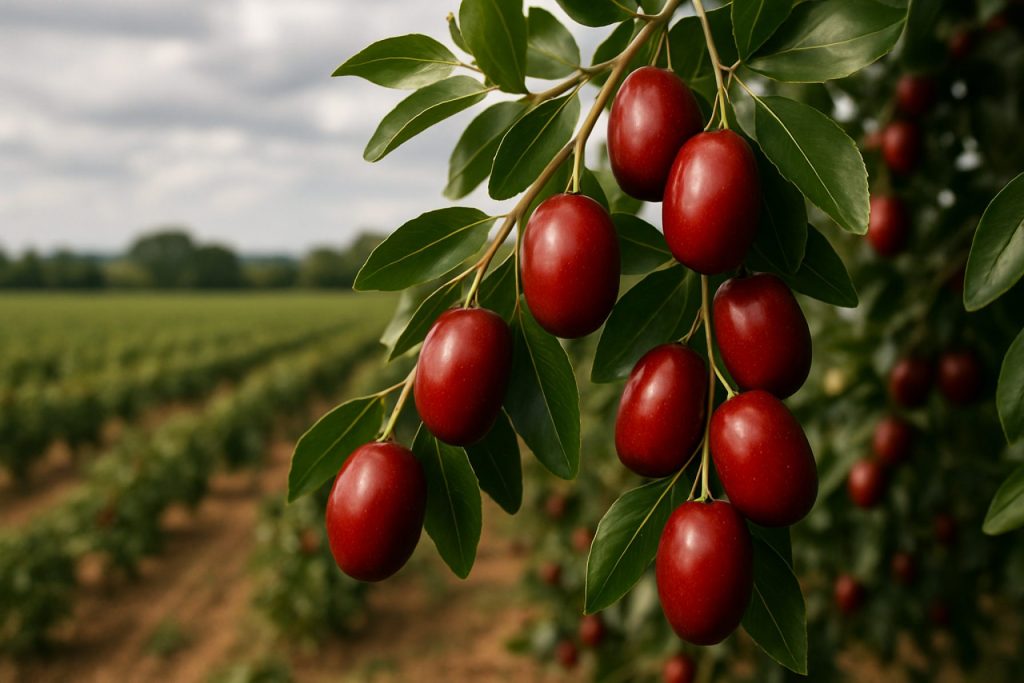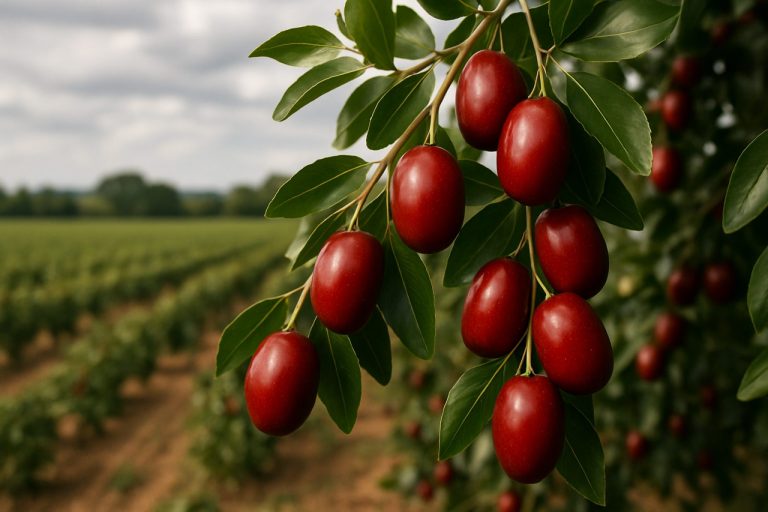
Table of Contents
- Executive Summary: 2025 Outlook and Key Trends
- Market Size, Growth, and Forecasts to 2030
- Genomic Technologies Transforming Jujube Crops
- Leading Innovators: Companies and Research Initiatives
- Regulatory Landscape and Global Policy Developments
- Adoption Barriers and Grower Perspectives
- Sustainability and Climate Resilience Benefits
- Commercialization: Supply Chain and Export Opportunities
- Investment Trends and Funding Activity
- Future Outlook: Emerging Technologies and Competitive Landscape
- Sources & References
Executive Summary: 2025 Outlook and Key Trends
Jujube (Ziziphus jujuba), a fruit crop of growing global importance, is entering a new era of improvement driven by advances in genomic technologies. As of 2025, the integration of genomics and molecular breeding is accelerating the development of jujube varieties with enhanced yield, nutritional quality, stress resistance, and adaptability—traits crucial for meeting rising market and climate challenges.
Recent breakthroughs have centered on high-quality genome sequencing and annotation, enabling the identification of genes linked to fruit size, sugar content, and abiotic stress tolerance. In 2023-2024, major Chinese research institutions, in collaboration with leading agricultural genomics companies, completed refined reference genomes for key commercial jujube cultivars. These resources underpin marker-assisted selection and genome editing programs now being implemented by breeders in China, the world’s largest jujube producer (BGI Genomics; HAI Agri-Tech).
One of the most significant trends for 2025 is the application of CRISPR and related gene-editing technologies to accelerate trait improvement. The first field trials of gene-edited jujube plants—aimed at improving drought tolerance and fruit shelf-life—are underway, with commercialization anticipated within the next three to five years, contingent on regulatory approval (Syngenta). Parallel efforts are focusing on using genomic selection to combine multiple desirable traits, reducing breeding cycles from decades to just a few years.
International collaborations are also expanding, with companies in Europe and the Middle East partnering with Chinese breeders to introduce jujube as a climate-resilient crop in new geographies. These partnerships are facilitating the exchange of germplasm and genomic data, and the adaptation of elite lines to local growing conditions (KWS SAAT SE & Co. KGaA). Moreover, digital platforms dedicated to jujube genetic resources are being deployed, streamlining breeding pipeline management and trait tracking.
Looking ahead to 2025 and beyond, the sector is poised for rapid transformation. The convergence of high-throughput genotyping, precision phenotyping, and AI-driven breeding analytics promises to further accelerate jujube improvement. Regulatory clarity on gene-edited crops in China and emerging markets will be a pivotal factor shaping the pace and breadth of commercial adoption. Overall, the jujube industry is expected to witness expanded cultivar diversity, improved resilience, and enhanced value chain integration, positioning it as a model for genomic crop enhancement in perennial fruit species.
Market Size, Growth, and Forecasts to 2030
The global market for jujube genomic crop enhancement is positioned for substantial growth through 2030, driven by increasing demand for high-yielding, disease-resistant cultivars and rapidly advancing genomic technologies. In 2025, market activity is centered in China, which remains the leading producer and research hub for jujube, accounting for over 90% of global output. Major Chinese agricultural genomics organizations, such as Zhejiang University and institutions under the Chinese Academy of Agricultural Sciences, continue to pioneer sequencing, genomic selection, and gene editing efforts focused on Ziziphus jujuba. These efforts are complemented by collaborations with international partners to accelerate breeding pipelines and deploy new cultivars with superior agronomic traits.
Since the release of the first high-quality jujube genome assembly, recent events have seen a proliferation of marker-assisted selection and CRISPR-based gene editing applications in breeding programs. In 2025, several pilot-scale commercial plantations in China and South Korea are testing elite lines with improved fruit quality, enhanced nutritional value, and increased tolerance to biotic and abiotic stresses. Additionally, the expansion of genomic service providers, including Novogene and BGI, is making advanced sequencing and bioinformatics platforms more accessible to breeders and growers across key Asian markets.
- In 2025, industry stakeholders are reporting a surge in both public and private investment in jujube genomic R&D, especially in the context of climate resilience and sustainable agriculture initiatives. The Chinese Academy of Agricultural Sciences has launched new collaborative projects aimed at integrating omics data to expedite trait discovery and select high-performing jujube lines for commercial release.
- The adoption of next-generation sequencing and phenotyping tools is forecast to accelerate the release of improved jujube cultivars, with at least 3-5 new varieties expected to reach market introduction by 2027, according to projections by BGI.
- By 2030, the market value for jujube genomic crop enhancement is projected to grow at a CAGR in the high single digits, with Asia-Pacific maintaining dominance but with emerging interest from Mediterranean and Middle Eastern countries seeking drought-tolerant varieties.
Overall, the outlook for jujube genomic crop enhancement is robust, with innovation in genomics tools and breeder engagement expected to drive commercial adoption, yield gains, and expanded cultivation into new geographies over the next five years.
Genomic Technologies Transforming Jujube Crops
The field of jujube (Ziziphus jujuba) genomic crop enhancement is poised for significant breakthroughs in 2025, driven by accelerating advances in sequencing, gene editing, and trait mapping technologies. In recent years, the complete reference genome for Chinese jujube has provided an essential genetic blueprint for researchers, enabling the functional annotation of genes associated with fruit quality, disease resistance, and stress tolerance. Building on these foundations, industry stakeholders are now integrating high-throughput genotyping and marker-assisted selection (MAS) into breeding pipelines, aiming to shorten breeding cycles and enhance desired traits with greater precision.
One of the pivotal developments in 2025 is the application of CRISPR/Cas9 and related genome-editing tools to jujube. Researchers at institutions such as the Chinese Academy of Agricultural Sciences are leveraging CRISPR systems to target genes governing fruit firmness, sugar content, and resistance to jujube witches’ broom, a major disease affecting yield and quality. Pilot field trials initiated in 2023 have demonstrated promising results, with edited lines exhibiting up to 25% higher sugar content and enhanced resistance to biotic stresses. These results lay the groundwork for commercial deployment subject to regulatory approvals.
The integration of genomic selection (GS) platforms has also accelerated jujube improvement efforts. Companies like BGI Genomics have developed cost-effective, high-throughput sequencing arrays tailored for perennial fruit crops, supporting breeders with rapid and large-scale genotypic data. By 2025, collaborative projects between genomic service providers and leading nurseries in China and Central Asia are facilitating the identification of elite genotypes with superior fruit size and shelf life—traits increasingly demanded by both domestic and international markets.
Looking ahead, the next few years are expected to witness the expansion of pan-genome projects for jujube, capturing the full spectrum of genetic diversity across wild and cultivated populations. These efforts will be critical for uncovering novel alleles for abiotic stress tolerance, a priority as climate change intensifies. Additionally, public–private partnerships, such as those coordinated by the Food and Agriculture Organization of the United Nations, are expected to promote the dissemination of advanced genomic resources and best practices, supporting sustainable jujube production on a global scale.
With the convergence of advanced genomics, digital phenotyping, and precision breeding, 2025 marks a transformative period for jujube crop enhancement. The combination of trait-focused molecular tools and international collaboration will likely propel jujube toward higher yields, improved quality, and broader adaptation in the coming years.
Leading Innovators: Companies and Research Initiatives
Jujube (Ziziphus jujuba) is rapidly gaining recognition as a candidate for genomic crop enhancement due to its nutritional value, resilience, and economic potential. As of 2025, the field is propelled by a collaborative ecosystem of academic research, government-supported breeding programs, and high-tech agricultural enterprises investing in genomic technologies.
A pivotal development was the complete sequencing of the jujube genome, which has enabled researchers to identify genes responsible for fruit quality, disease resistance, and environmental stress tolerance. Chinese Academy of Agricultural Sciences (CAAS) continues to lead in applying genome editing technologies such as CRISPR/Cas9 to accelerate the breeding of improved jujube varieties. Their Breeding and Cultivation Research Institute has released new lines with enhanced sugar content and resistance to jujube witches’ broom disease, targeting both domestic and international markets.
In the private sector, Syngenta has entered collaborations with local Chinese agricultural biotech firms to integrate marker-assisted selection and precision phenotyping into jujube breeding pipelines. These partnerships aim to cut breeding cycles significantly—by as much as 40%—by leveraging genomic data to predict desirable traits before field testing. Syngenta’s involvement also extends to pilot projects in Northwestern China, where climate-resilient jujube cultivars are being deployed to marginal lands.
Another major player, China National Seed Group Co., Ltd., is actively investing in the commercial scale-up of elite jujube varieties. Their initiatives include the establishment of large-scale demonstration orchards and the development of proprietary molecular markers to ensure genetic purity and traceability throughout the supply chain.
On the international front, the CGIAR network has launched cross-border projects aimed at introducing genomic tools for jujube improvement in Central Asia and the Mediterranean—regions with growing interest in drought-tolerant fruit crops. These initiatives focus on germplasm exchange, capacity building, and the adaptation of genomic selection protocols to local conditions.
Looking ahead to the next few years, continued integration of genomics, bioinformatics, and sustainable agronomic practices is set to transform jujube into a model crop for climate-smart agriculture. Industry analysts expect the launch of new value-added jujube products, supported by robust traceability systems and data-driven breeding. With leading innovators expanding R&D investments and international collaboration, jujube genomic crop enhancement is poised for accelerated impact through 2025 and beyond.
Regulatory Landscape and Global Policy Developments
The regulatory landscape for jujube (Ziziphus jujuba) genomic crop enhancement is experiencing dynamic evolution as global interest in gene-edited and genomically improved crops increases. In 2025, regulatory frameworks in leading agricultural economies such as China, the United States, and the European Union are shaping the trajectory of jujube genomics through updated policies, pilot programs, and risk assessment protocols tailored for gene-edited crops.
China, the world’s largest producer of jujube, continues to spearhead genomic innovation in the crop. In February 2022, China’s Ministry of Agriculture and Rural Affairs (MARA) issued new guidelines to accelerate the approval of gene-edited crops, differentiating them from traditional GMOs in regulatory terms. These guidelines streamline field trials and commercialization for gene-edited varieties, including those targeting disease resistance and fruit quality improvements in jujube. By 2025, several pilot projects led by Chinese agricultural research institutes are underway, leveraging CRISPR-based techniques to improve traits such as sugar content and stress tolerance in jujube, with regulatory compliance monitored under MARA’s updated protocols (Ministry of Agriculture and Rural Affairs of the People's Republic of China).
In the United States, the U.S. Department of Agriculture (USDA) has clarified its regulatory approach for gene-edited crops, generally exempting those that could have been developed through conventional breeding from strict GMO regulations. While large-scale commercial cultivation of gene-edited jujube is not yet reported, research collaborations involving land-grant universities and specialty crop programs have submitted notifications and received non-regulated status for gene-edited fruit crops, setting precedents that are expected to benefit jujube as genomic enhancements reach advanced stages (United States Department of Agriculture).
The European Union maintains a more precautionary approach, with recent discussions in 2024 and 2025 signaling potential reforms to the 2001 GMO Directive. The European Food Safety Authority (EFSA) is conducting ongoing consultations and scientific opinions specifically regarding new genomic techniques (NGTs), including their application to minor and specialty crops like jujube. Any policy shifts in the coming years could significantly impact the import, research, and potential cultivation of genomically enhanced jujube in Europe (European Food Safety Authority).
Looking ahead, international harmonization of regulatory standards for gene-edited crops remains a key challenge. Organizations such as the International Plant Protection Convention (IPPC) and the Organization for Economic Co-operation and Development (OECD) are actively engaging stakeholders to align risk assessment and labeling protocols. These initiatives are expected to facilitate cross-border research collaboration and market access for genomic jujube varieties over the next several years (International Plant Protection Convention).
Adoption Barriers and Grower Perspectives
The adoption of genomic crop enhancement technologies in jujube (Ziziphus jujuba) is progressing, yet several barriers and nuanced grower perspectives shape the pace and scale of implementation as of 2025. While the sequencing of the jujube genome and advances in marker-assisted selection and gene editing have enabled the identification of traits for yield, disease resistance, and fruit quality, the translation of these innovations from research to widespread field use remains uneven.
A primary barrier is the limited awareness and technical capacity among smaller jujube growers to integrate genomic tools into their breeding programs. Many growers, especially in traditional production regions such as China, rely on conventional propagation methods and exhibit caution towards adopting unfamiliar biotechnology, citing concerns over cost, complexity, and potential regulatory hurdles. The China Forestry Association reports that education and extension programs are still ramping up to bridge the knowledge gap, with adoption highest among larger, export-oriented enterprises.
Regulatory uncertainty also impedes adoption. While gene-edited crops are subject to different regulatory frameworks than transgenic GMOs in some jurisdictions, ambiguity remains in key markets about the status of jujube varieties developed through CRISPR or other editing techniques. The Ministry of Agriculture and Rural Affairs of the People's Republic of China has issued draft guidelines for gene-edited crop approval, but as of 2025, full-scale commercialization of gene-edited jujube varieties awaits further regulatory clarity.
Grower perspectives are further shaped by market considerations. Exporters aiming for premium markets in Europe and North America express concern over consumer acceptance and potential trade barriers for genomically enhanced fruits. Meanwhile, domestic market-focused producers are more receptive, especially where disease resistance and climate resilience traits address urgent agronomic challenges. The China Fruit Marketing Association notes that demonstration projects and performance data from field trials are key to building confidence among skeptical growers.
Looking ahead to the next few years, initiatives by public research institutes and industry groups to provide training, disseminate field trial data, and clarify intellectual property issues are expected to gradually lower adoption barriers. The expansion of collaborative breeding programs and pilot projects—supported by organizations such as the Chinese Academy of Agricultural Sciences—suggests a cautiously optimistic outlook for wider uptake of genomic enhancement technologies in jujube cultivation, contingent on regulatory harmonization and ongoing grower engagement.
Sustainability and Climate Resilience Benefits
Jujube (Ziziphus jujuba) is gaining global attention as a climate-resilient fruit crop, especially in arid and semi-arid regions. Recent genomic crop enhancement initiatives are catalyzing its potential to contribute to sustainable agriculture and climate change adaptation. As of 2025, multiple breeding programs leveraging high-quality genome assemblies and advanced molecular markers are rapidly increasing the crop’s tolerance to abiotic stresses such as drought, salinity, and extreme temperatures.
Significant progress has been made in sequencing and annotating the jujube genome, with publicly available reference genomes now serving as the foundation for marker-assisted selection and gene editing. These advancements enable breeders to identify and incorporate genetic traits for resilience and sustainability more efficiently. For example, the Chinese Academy of Agricultural Sciences (CAAS) has been instrumental in developing drought- and salinity-tolerant jujube lines, which are now being evaluated in multi-location field trials across China’s northern provinces.
From a sustainability perspective, jujube’s improved genomic varieties reduce reliance on irrigation and agrochemicals, lowering the crop’s environmental footprint. Enhanced cultivars with higher nutrient use efficiency and pest resistance are being rapidly adopted by commercial growers, as reported by the Chinese Society of Agricultural Sciences. These cultivars require fewer chemical inputs, which contributes to improved soil health and reduced greenhouse gas emissions associated with traditional fruit farming.
Additionally, the jujube’s deep-rooted system, now being optimized through genomics, improves carbon sequestration and soil stabilization—key factors in climate adaptation strategies. The Food and Agriculture Organization of the United Nations (FAO) highlights jujube’s resilience and sustainability in its recent technical briefs, promoting the crop for marginal lands prone to desertification.
Looking ahead to 2025 and beyond, the integration of CRISPR and other gene-editing technologies is expected to accelerate, with several pilot projects already underway to fine-tune traits such as fruit quality, storage resilience, and further stress tolerance. Collaborative networks, including partnerships between CAAS, the CGIAR, and regional agricultural extension services, are set to scale dissemination of improved jujube cultivars, empowering smallholder farmers in climate-vulnerable regions.
In summary, jujube genomic crop enhancement is poised to deliver robust sustainability and climate resilience benefits, making it a model for future-oriented, resource-efficient agriculture in the era of global climate change.
Commercialization: Supply Chain and Export Opportunities
The commercialization of genomic crop enhancement in jujube (Ziziphus jujuba) is poised for significant growth in 2025 and the years immediately following, driven by advances in molecular breeding, precision genomics, and increasing global demand for nutraceutical crops. With the recent decoding of the jujube genome, breeders are leveraging marker-assisted selection and CRISPR/Cas9-based editing to develop cultivars with improved fruit quality, disease resistance, and climate resilience. This genomic progress is beginning to influence supply chain dynamics and open new export avenues, particularly for high-value processed products such as dried jujubes, extracts, and functional ingredients.
In China, which accounts for over 90% of global jujube production, leading agricultural biotechnology firms have begun integrating genomic tools into their commercial breeding programs. Entities like Syngenta Group and COFCO Corporation have announced collaborations with research institutes to accelerate the commercialization of enhanced jujube varieties. These efforts are expected to shorten breeding cycles, improve post-harvest characteristics, and ensure a more consistent supply of premium-grade fruit for both domestic processing and international markets.
On the export front, rising awareness of jujube’s health benefits is driving substantial demand in markets such as the European Union, North America, and Southeast Asia. Enhanced genomic varieties—engineered for uniformity, shelf-life, and bioactive compound content—are anticipated to boost export competitiveness for suppliers. Organizations such as the Chinese Academy of Agricultural Sciences are working to align new cultivars with international phytosanitary and food safety standards, facilitating easier market access.
Supply chain modernization is also underway. The adoption of digital traceability solutions, blockchain platforms, and smart logistics—piloted by companies like JD.com for tracking specialty crops—aim to assure buyers of product provenance and quality. These technologies, when combined with genomically enhanced jujube varieties, are expected to streamline export certification and reduce losses during transit.
Looking ahead to 2026-2028, industry observers anticipate further integration of genomic data into end-to-end production and supply systems. This will likely lead to contract farming models and vertically integrated supply chains designed to meet the specific requirements of global food, beverage, and nutraceutical industries. As regulatory environments in key importing regions become more receptive to gene-edited crops, the export of advanced jujube cultivars is expected to rise, positioning the sector for robust growth in the next several years.
Investment Trends and Funding Activity
Investment in jujube genomic crop enhancement has accelerated in recent years, reflecting the growing recognition of jujube’s potential as a high-value, climate-resilient fruit crop. In 2025, both public and private sector funding has concentrated on leveraging genomics for improved yield, disease resistance, and nutritional quality.
China, as the world’s leading jujube producer, continues to play a pivotal role. The Chinese Academy of Agricultural Sciences (CAAS) has expanded its genomic research initiatives, with multi-year funding aimed at sequencing new jujube varieties and deploying marker-assisted selection in breeding programs. Investment from provincial agricultural bureaus has supported the establishment of genomics centers in Xinjiang and Hebei, focusing on local landraces and stress tolerance traits.
Internationally, partnerships have emerged to tap into jujube’s expanding export markets. In 2024, ICRISAT (International Crops Research Institute for the Semi-Arid Tropics) initiated a collaborative program with CAAS and Indian horticultural institutes to co-invest in jujube genomic resources, targeting drought resilience for arid-zone agriculture. This is expected to attract further funding from multilateral agencies through 2025 and beyond.
On the private sector side, agri-biotech companies are increasing their presence. BGI Genomics, a global genomics leader, has announced new investments in high-throughput sequencing of jujube germplasm to facilitate commercial breeding pipelines. Seed technology firms in China and Israel are exploring licensing agreements to access proprietary jujube genome-editing tools, with pilot projects projected to enter field trials by late 2025.
Venture capital activity remains nascent but is gaining traction as jujube’s health benefits drive interest in functional foods and nutraceuticals. Early-stage funding rounds have been reported for start-ups focused on CRISPR-enabled jujube varieties, particularly those targeting improved fruit quality and shelf life. These investments are expected to increase if regulatory frameworks for gene-edited crops in Asia and the Middle East become more favorable in the next two to three years.
Looking ahead, investment in jujube genomic crop enhancement is poised for continued growth through 2027, fueled by rising global demand and the strategic alignment of genomics with sustainable agriculture initiatives. Public-private partnerships and international collaborations are likely to drive both the pace and scale of innovation in the sector.
Future Outlook: Emerging Technologies and Competitive Landscape
The future of jujube (Ziziphus jujuba) genomic crop enhancement is increasingly shaped by advances in biotechnology and genomics, as well as growing global demand for resilient, high-value fruit crops. As of 2025, the integration of CRISPR-Cas9 gene editing and advanced marker-assisted selection is accelerating the development of new jujube cultivars with improved disease resistance, fruit quality, and environmental adaptability.
Several Chinese research institutes and agricultural technology companies are leading the charge in genomic research and crop breeding. For instance, the Chinese Academy of Agricultural Sciences (CAAS) has sequenced multiple jujube genomes, enabling the identification of genes linked to traits such as fruit texture, sugar content, and resistance to jujube witches’ broom disease. These genomic resources are being deployed in breeding programs to shorten development cycles and produce cultivars tailored for both domestic and export markets.
In parallel, companies like Syngenta Group China are collaborating with national institutes to introduce advanced biotechnology platforms, facilitating high-throughput genotyping and phenotyping of jujube varieties. Such partnerships are expected to culminate in the commercial release of gene-edited jujube lines within the next 2–4 years, pending regulatory approvals and consumer acceptance.
The competitive landscape is also expanding beyond China. Institutions in Korea and Israel are leveraging genomic data to enhance local jujube cultivars, focusing on traits such as drought tolerance and post-harvest shelf life, which are critical for international supply chains (Korea Ministry of Agriculture, Food and Rural Affairs). These developments are fostering a more dynamic, innovation-driven market, with licensing agreements and joint ventures expected to increase as proprietary germplasm and gene-editing technologies become more widely adopted.
Looking ahead, the next few years will likely see the convergence of digital agriculture tools—such as AI-driven trait prediction and blockchain-based supply chain tracking—with genomic crop enhancement. This integration promises to further accelerate breeding cycles, enhance traceability, and address consumer concerns regarding genetically edited crops. Industry stakeholders anticipate that these technological advances will position jujube as a model fruit crop for climate-resilient, health-focused agriculture, both in Asia and in emerging markets worldwide (Food and Agriculture Organization of the United Nations).
Sources & References
- BGI Genomics
- Syngenta
- KWS SAAT SE & Co. KGaA
- Zhejiang University
- Chinese Academy of Agricultural Sciences
- Novogene
- Food and Agriculture Organization of the United Nations
- CGIAR
- European Food Safety Authority
- International Plant Protection Convention
- JD.com
- ICRISAT
- Syngenta Group China



